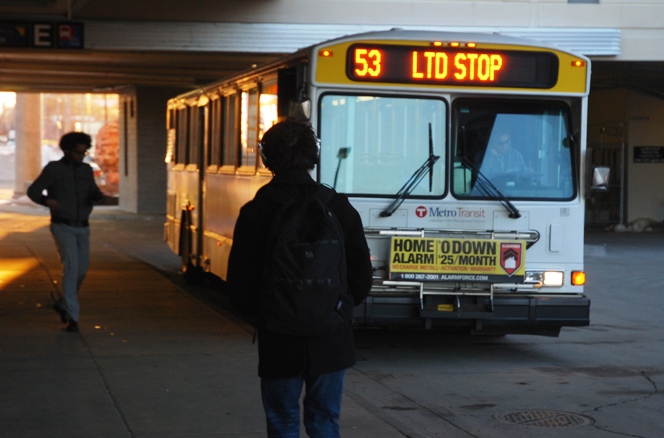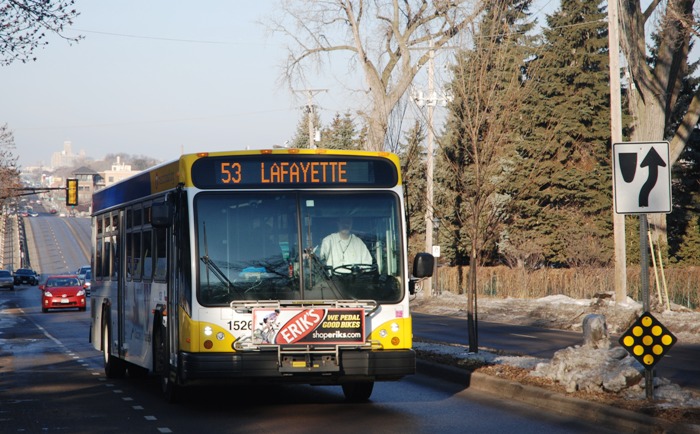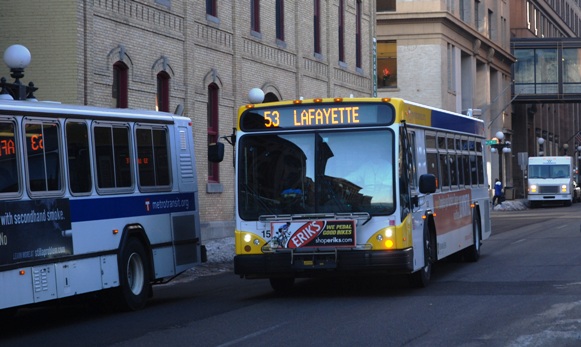 Jeff Nelson likes to be productive – even when he’s commuting.
Jeff Nelson likes to be productive – even when he’s commuting.
That’s why, for nearly a decade, he’s been taking the bus to his job at the Department of Employment and Economic Development in St. Paul. In the summer months, he combines short bike trips with a ride on Route 94. In the winter, when his routine includes morning visits to a gym near Nicollet Avenue and Lake Street, he catches Route 53.
One of the main reasons: he can use the time on the bus to squeeze in a little more work at the beginning and end of each workday, reading and catching up on e-mail while moving to and from the office.
“One of the biggest reasons I take the bus is that driving on I-94 can be such a pain,” Nelson said during a recent morning trip on Route 53. “Sitting in traffic, I’m just burning gas and wasting time.”
Nelson’s philosophy was shared by many commuters on Route 53, which travels between the Uptown Transit Center and downtown St. Paul along Lake Street, Marshall Avenue and Interstate 94. The route includes stops at the Chicago/Lake Transit Center and the METRO Blue Line’s Lake Street/Midtown Station.
Between Uptown and Snelling Avenue, Route 53 covers much of the same terrain as Route 21. But it offers a quicker trip with around one-third the number of stops and also non-stop service on I-94 between Snelling Avenue and downtown St. Paul. Route 53 buses run only on weekdays, with eight eastbound trips each morning rush hour and ten westbound trips each evening rush hour.
Liam Moore, who boards at Otis and Marshall avenues, appreciates the efficiency of his limited-stop trip to downtown St. Paul, where he works at the Science Museum of Minnesota. Moore and his girlfriend share a vehicle, so he takes the bus to work every day.
“It’s nice because it’s such a direct route to downtown St. Paul,” Moore said.
Other eastbound commuters who travel shorter distances use the Route 53 and Route 21 interchangeably, based on their schedules.
Among them is DeAndre Lindsey, who takes Route 17 from his home in St. Louis Park and transfers to Route 53 or Route 21 at the Uptown Transit Center to get to work near Lake Street and Blaisdell Avenue. Though he could drive, Lindsey has been commuting by transit for the last eight years because he sees it as a cheaper and easier way of getting to work.
 “And it forces me to stay on time,” Lindsey said.
“And it forces me to stay on time,” Lindsey said.
Audrey Blanchard, who also boarded at the Uptown Transit Center, said she too could drive but prefers to take transit. Blanchard rides Route 53 to the Chicago/Lake Transit Center, near her workplace at the Midtown Exchange, and appreciates not having to pay for parking while on the clock.
“I could drive, but this is just much more convenient,” Blanchard said. “I’ve got my schedule down so this is easy.”
For Linda Griffin, riding the bus is also about convenience. Griffin takes Route 53 three times a week to the Division of Indian Work, where she volunteers. “I like the fact that I don’t have to warm up my car in the winter, but even in the summer I ride,” she said.
Route 53 customers who travel to St. Paul will have another transit option when the METRO Green Line opens June 14. Route 53 buses will connect with the Green Line’s Central Station, at 5th and Cedar streets, and the Union Depot, the Green Line’s eastern terminus.
Though not considered a major feeder route for the Green Line, employees who work north of downtown St. Paul on Lafayette Road could use Route 53 to get to the Green Line’s downtown stations.
Route 53 customers may also someday see changes to service on the Lake Street corridor. A recent study of transit in the Midtown Corridor concluded with a recommendation for Bus Rapid Transit on Lake Street and rail in the Midtown Greenway.
BRT would cut travel time by offering fewer stops and technologies like off-board fare payment and traffic signal priority. Route 21 will continue to operate alongside BRT but Route 53 would be replaced. Select BRT trips could continue from Snelling Avenue to downtown St. Paul during rush hour.
 Route 53 At a Glance
Route 53 At a Glance
Type: Limited stop
Service: Route 53 runs between the Uptown Transit Center and downtown St. Paul, along Lake Street, Marshall Avenue and I-94. Eight eastbound trips depart Minneapolis each morning between approximately 6 a.m. and 8:30 a.m. In the evening, ten westbound trips depart St. Paul between approximately 2:30 p.m. and 6 p.m. The Chicago/Lake Transit Center and METRO Blue Line’s Lake Street/Midtown Station are major transfer points along the route. Route 21 covers similar territory as Route 53, but has more stops. Route 21 also makes stops at University Avenue and Snelling Avenue and on Selby Avenue in St. Paul.
Route Length: Approximately 12 miles
Stops: 33 eastbound; 33 westbound
Vehicles: Standard 40-foot buses
Ridership: More than 216,000 customer boardings in 2013, with an average of 859 passengers per day. Ridership grew more than 8 percent between 2012 and 2013.
History: The Selby-Lake streetcar line operated from 1906 until 1953 and was among the most important crosstown connections in the burgeoning streetcar system, with more passengers per mile than any other route. An express bus also traveled on Lake Street to downtown St. Paul in the 1920s, competing with the Selby-Lake streetcar. Route 53 is the successor of that express bus service.
Future: When the METRO Green Line opens June 14, Route 53 customers will be able to transfer to the train at the Union Depot and Central Station. The Midtown Corridor Alternatives Analysis also recommended Bus Rapid Transit on Lake Street, between the METRO Blue Line’s Lake Street/Midtown Station and the proposed West Lake Station on the METRO Green Line Extension (Southwest LRT). BRT features could be continued on Marshall and Snelling avenues, connecting with the Green Line’s Snelling Avenue Station.